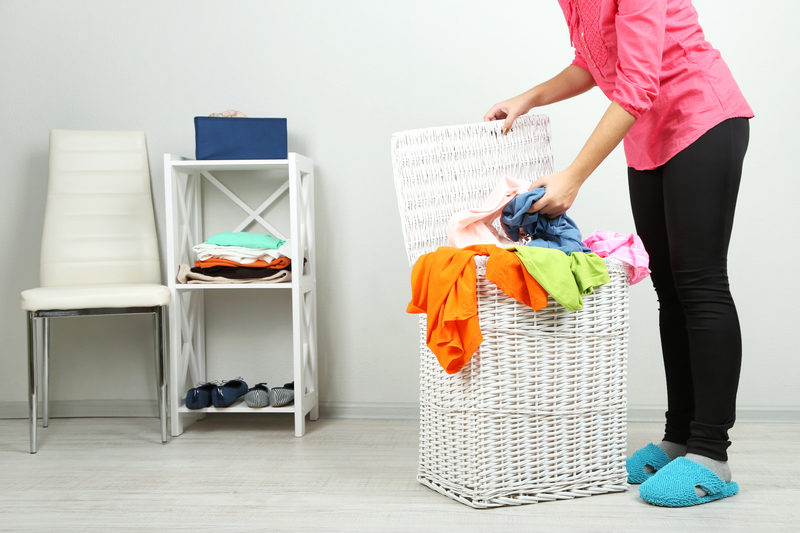A Breath of Fresh Air: Elevating Indoor Environments
Posted on 17/06/2025
A Breath of Fresh Air: Elevating Indoor Environments
In today's rapidly evolving urban landscapes, where people spend up to 90% of their time indoors, the quality of the air and atmosphere within enclosed spaces has never been more pivotal. Creating a healthy and inviting indoor environment is not just about aesthetic appeal--it's about fostering wellness, productivity, and comfort. This comprehensive guide explores ways to elevate indoor environments, the significance of optimal indoor air quality (IAQ), and actionable strategies to ensure every breath indoors is truly a breath of fresh air.
Why a Healthy Indoor Environment Matters
For generations, humanity prioritized shelter from the elements, but as our lives have become increasingly indoor-centric, attention has shifted toward what's inside our homes, offices, and public buildings. A refreshing indoor atmosphere does more than prevent disease--it enhances mood, cognition, and overall well-being. Let's look at why prioritizing air and environment indoors is crucial.
- Health Protection: Poor indoor air is linked to asthma, allergies, respiratory illness, and even cardiovascular issues.
- Productivity & Comfort: Clean, properly ventilated spaces improve concentration and comfort, vital for work and relaxation.
- Economic Value: Healthier spaces lead to fewer sick days and lower healthcare costs.
The Invisible Challenge: Air Quality Inside
When discussing indoor environments, it's easy to overlook what we can't see: the air itself. Many assume outdoor pollution is the main threat, but *indoor air can be up to five times more polluted* than outdoor air, according to the Environmental Protection Agency (EPA). Sources of indoor air pollution include:
- Volatile organic compounds (VOCs) from paints, cleaning agents, and furniture
- Mold and mildew from excess humidity
- Dust mites and pet dander
- Carbon monoxide and other gases from appliances
- Outdoor pollutants seeping indoors

Proven Ways to Elevate Indoor Environments
Elevating indoor environments doesn't have to be overwhelming. By focusing on controlling pollutants, enhancing ventilation, and incorporating biophilic design principles, anyone can craft a healthier, more uplifting living or working space.
1. Ventilation: The Cornerstone of Fresh Air
One of the most effective methods for improving indoor air is enhancing ventilation. Proper ventilation helps dilute and remove airborne contaminants, ensuring a steady influx of oxygen and a reduction in pollutants.
Tips for Optimal Indoor Ventilation:- Open Windows Regularly: Even just fifteen minutes can bring in a wave of freshness and help flush out stale air.
- Use Exhaust Fans: Kitchens and bathrooms are prone to humidity and odors; exhaust fans quickly remove these.
- Consider Mechanical Ventilation: HVAC systems with fresh air intake or heat recovery ventilators (HRVs) can maintain circulation without sacrificing comfort or energy efficiency.
2. Air Purification: Targeting Pollutants Directly
If fresh air intake is limited--common in urban high-rises or dense developments--air purifiers are invaluable for elevating indoor air quality:
- HEPA Filters: Capture dust, pollen, and particulates as small as 0.3 microns.
- Activated Carbon:** Neutralizes odors, chemicals, and certain volatile organic compounds.
- UV-C Light Purifiers: Kill bacteria, viruses, and mold spores for extra peace of mind.
Note: When choosing an air purifier, select the right size and verify independent certifications (such as AHAM or CADR ratings).
3. Control Humidity for Comfort and Health
*Balancing indoor humidity* is critical--it prevents mold growth, dust mites, and preserves building integrity. The optimal indoor humidity level is between 30% and 50%.
- Dehumidifiers: Useful in damp climates or basements.
- Humidifiers: Reintroduce moisture during dry winters or in arid regions.
- Regularly check and maintain HVAC systems to prevent condensation issues.
4. Embrace Biophilic Design: Nature Indoors
Biophilic design isn't just a trend--it's a science-backed approach that *elevates indoor spaces* by integrating elements of nature. Benefits include reduced stress, improved mood, and enhanced air quality through the use of indoor plants.
Easy Ways to Bring Biophilia Home or to Work:- Indoor Plants: Peace lilies, ferns, snake plants, and pothos are not only air-purifying but also low maintenance.
- Natural Light: Maximize sunlight exposure for circadian rhythm health.
- Nature-Inspired Decor: Use natural materials like wood, cork, and stone to foster warmth and comfort.
The Role of Building Materials and Furnishings
Elevating indoor environments involves not just air, but also the surfaces and items within a space. Many furnishings, flooring, and wall treatments contribute VOCs and other pollutants.
Lower Your Indoor Pollution Footprint by:- Choosing Low-VOC Products: Look for paint, sealants, carpets, and upholstery labeled "low VOC" or "no VOC."
- Avoiding Pressed Wood Furniture: Or select certified formaldehyde-free options.
- Regularly cleaning and vacuuming with HEPA-filter appliances.
Eco-Friendly Maintenance for Lasting Freshness
*Green cleaning habits* go a long way in maintaining a fresh and safe environment. Choose non-toxic cleaning products--they prevent the release of harmful chemicals and are safer for people and pets alike.
Behavioral Strategies That Help Indoor Environments Thrive
Even the best equipment and design choices benefit from mindful behaviors and ongoing care. Cultivating daily habits can lead to consistently elevated indoor atmospheres.
- Leave shoes at the door to prevent bringing in contaminants.
- Wash bedding, curtains, and soft furnishings regularly.
- Avoid smoking indoors--this is a major and persistent pollutant.
- Limit the use of candles and incense to special occasions.
Smart Tech and the Modern Indoor Environment
The digital revolution has introduced "smart home" technology that makes monitoring and improving indoor air quality easier than ever. Connected sensors and automated systems take the guesswork out of healthy living.
- Smart Air Quality Monitors: Detect VOCs, particulate matter, temperature, and humidity, sending alerts to your phone.
- Zoned Climate Controls: Customize temperature and airflow for each room to maximize comfort and efficiency.
- Automation of purifiers and fans ensures response to real-time air conditions.
Transforming Workplaces: Considering Office Air and Wellness
Corporate spaces play a huge role in daily well-being. A fresh, clean office environment does more than reduce sick days; it also attracts talent, boosts morale, and elevates overall productivity. Companies can prioritize fresh air in the office by:
- Investing in commercial-grade HVAC filtration and air exchangers.
- Incorporating live plants and green walls in office design.
- Setting up "wellness zones" or break areas near windows or natural light for decompression.
- Offering training on the importance of maintaining indoor air quality.
Case Study: Elevating Indoor Environments in Urban Residences
Consider a couple in a city apartment. At first, they notice headaches, dry eyes, and persistent dust, despite regular cleaning. After assessing their space, they realized:
- Poor airflow: Windows kept closed for security and noise.
- Sources of pollutants: New furniture off-gassing VOCs, gas stove without a vent hood.
- Lack of greenery: Few if any plants to support air purification.
By implementing simple changes such as adding air-purifying plants, ventilating for short periods, using an air purifier with a HEPA filter, and switching to green cleaning products, they elevated their apartment's indoor environment dramatically. Within weeks, symptoms subsided, and their home felt more comfortable and energizing--a true breath of fresh air in the city.
Sustainable and Future-Ready Indoor Spaces
As ecological awareness grows, the built environment is undergoing a revolution. New construction standards, such as WELL Building Standard and LEED certification, increasingly focus on elevating indoor environments from the ground up.
Forward-thinking Features Include:- Advanced air and water filtration systems
- Use of responsibly sourced, low-emission materials
- Integrating indoor-outdoor spaces for seamless biophilia
- Energy-saving lighting that supports natural sleep cycles
The Bottom Line: Everyone Deserves Fresh Air Indoors
Whether you're a homeowner, renter, workplace manager, or designer, *proactively improving indoor environments* is a life-changing investment. Small daily habits, smart design choices, and modern technology converge to create spaces that not only look good, but also feel invigorating and wholesome.
Practical Checklist: Steps Toward a Healthier Indoor Environment
- Ventilate: Open windows and use fans daily.
- Purge Pollutants: Minimize use of harsh cleaners and fragrances.
- Filter Air: Invest in an appropriately sized HEPA air purifier.
- Add Nature: Select a few resilient, air-purifying houseplants.
- Monitor Conditions: Use a smart device for air quality alerts.
- Mind Furnishings: Choose non-toxic, low-emission furniture and finishes.
- Control Humidity: Keep levels between 30-50% year-round.

Frequently Asked Questions About Fresh Indoor Environments
What's the most important step I can take today?
Regularly ventilate your space. Open windows and doors for even a few minutes per day to replace stale, polluted indoor air with fresh outdoor air.
Do houseplants really improve indoor air?
*Yes, although the effect is more noticeable with multiple plants and proper care.* Certain species like spider plant, pothos, and snake plant are especially effective for not only removing toxins but also boosting humidity and mood.
Is indoor air quality only a concern in cities?
No--sources of indoor pollution exist everywhere, including suburban and rural homes, from cleaning chemicals to allergens and building materials.
Conclusion: Transform Your Space with a Breath of Fresh Air
Elevating indoor environments is not a one-time project, but a continuing journey toward health, happiness, and sustainability. By staying mindful of air quality, embracing biophilic design, and leveraging simple habits, anyone can experience the transformative power of a truly fresh atmosphere indoors.
If you're ready to revitalize your home or office, remember: every fresh breath you take is an investment in your future. Start implementing these strategies today--and open the door to a healthier, more vibrant tomorrow.



